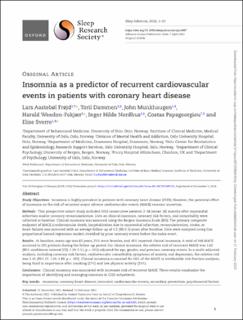| dc.contributor.author | Frøyd, Lars | |
| dc.contributor.author | Dammen, Toril | |
| dc.contributor.author | Munkhaugen, John | |
| dc.contributor.author | Weedon-Fekjær, Harald | |
| dc.contributor.author | Nordhus, Inger Hilde | |
| dc.contributor.author | Papageorgiou, Costas | |
| dc.contributor.author | Sverre, Elise Christine Bjørkholen | |
| dc.date.accessioned | 2023-04-03T12:33:38Z | |
| dc.date.available | 2023-04-03T12:33:38Z | |
| dc.date.created | 2022-08-27T14:51:18Z | |
| dc.date.issued | 2022 | |
| dc.identifier.issn | 2632-5012 | |
| dc.identifier.uri | https://hdl.handle.net/11250/3061849 | |
| dc.description.abstract | Abstract Study Objectives Insomnia is highly prevalent in patients with coronary heart disease (CHD). However, the potential effect of insomnia on the risk of recurrent major adverse cardiovascular events (MACE) remains uncertain. Methods This prospective cohort study included 1082 consecutive patients 2–36 (mean 16) months after myocardial infarction and/or coronary revascularization. Data on clinical insomnia, coronary risk factors, and comorbidity were collected at baseline. Clinical insomnia was assessed using the Bergen Insomnia Scale (BIS). The primary composite endpoint of MACE (cardiovascular death, hospitalization due to myocardial infarction, revascularization, stroke, or heart failure) was assessed with an average follow-up of 4.2 (SD 0.3) years after baseline. Data were analyzed using Cox proportional hazard regression models stratified by prior coronary events before the index event. Results At baseline, mean age was 62 years, 21% were females, and 45% reported clinical insomnia. A total of 346 MACE occurred in 225 patients during the follow-up period. For clinical insomnia, the relative risk of recurrent MACE was 1.62 (95% confidence interval [CI]: 1.24–2.11, p | en_US |
| dc.language.iso | eng | en_US |
| dc.publisher | Oxford University Press | en_US |
| dc.rights | Attribution-NonCommercial-NoDerivatives 4.0 Internasjonal | * |
| dc.rights.uri | http://creativecommons.org/licenses/by-nc-nd/4.0/deed.no | * |
| dc.title | Insomnia as a predictor of recurrent cardiovascular events in patients with coronary heart disease | en_US |
| dc.type | Journal article | en_US |
| dc.type | Peer reviewed | en_US |
| dc.description.version | publishedVersion | en_US |
| dc.rights.holder | Copyright 2022 The Author(s) | en_US |
| dc.source.articlenumber | zpac007 | en_US |
| cristin.ispublished | true | |
| cristin.fulltext | original | |
| cristin.qualitycode | 1 | |
| dc.identifier.doi | 10.1093/sleepadvances/zpac007 | |
| dc.identifier.cristin | 2046448 | |
| dc.source.journal | SLEEP Advances | en_US |
| dc.identifier.citation | SLEEP Advances. 2022, 3 (1), zpac007. | en_US |
| dc.source.volume | 3 | en_US |
| dc.source.issue | 1 | en_US |

